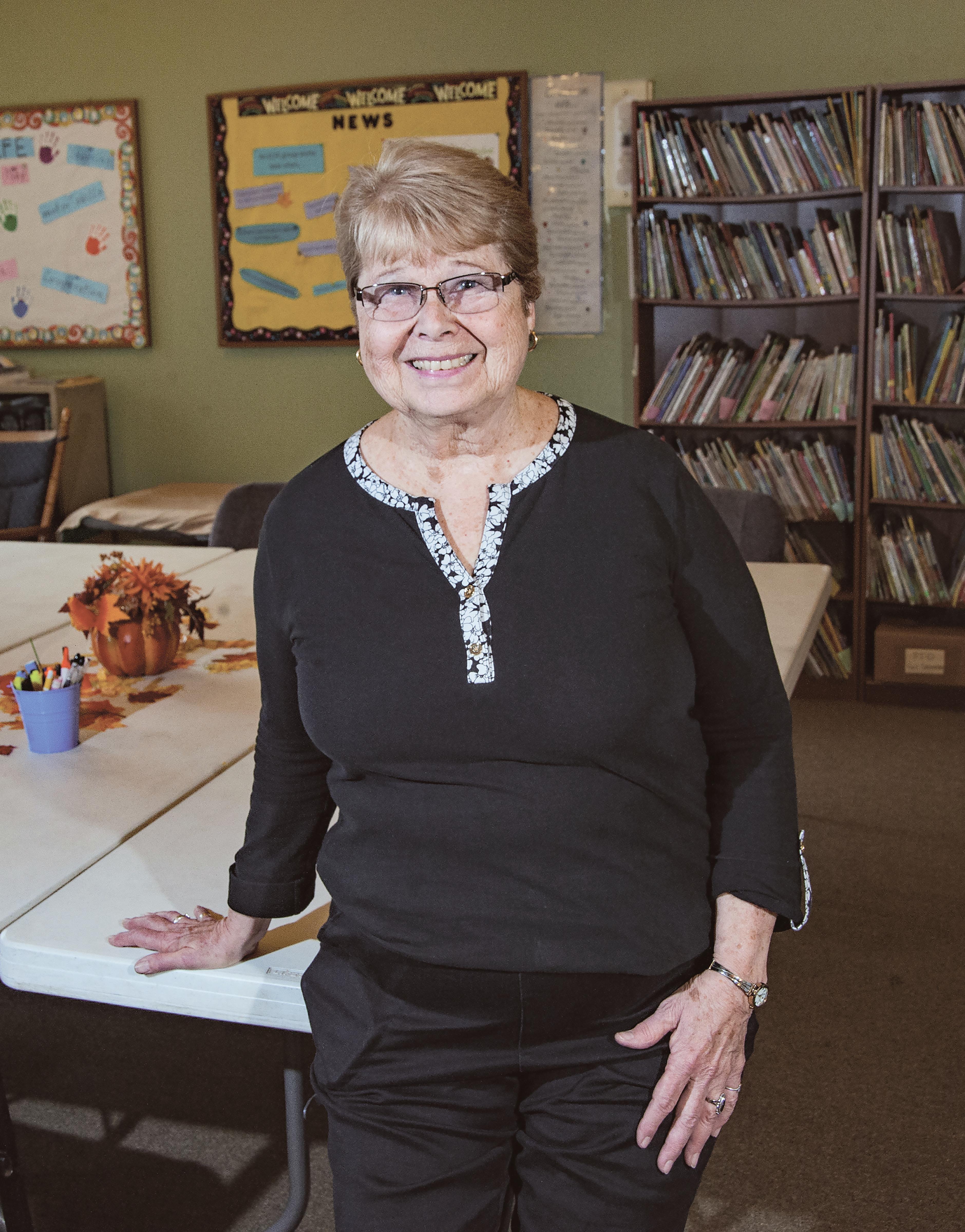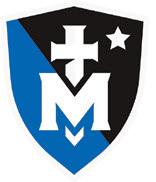LIVING IN THE PAST
North Shore Community School re-enacts voyageur and Ojibwe history

Social network connects chronically ill adolescents
Girls learn what Boy Scouts has to offer
Educators help grandparents care for next generation
Apple crisp cooks up warm memories

JANUARY • FEBRUARY 2019

Non-Profit Home Care Agency We accept major insurance plans; Medicaid and private pay. Call our Duluth office and ask about the possibilities! 218-724-2800 SERVING PEOPLE STATEWIDE www.accracare.org HELPING FAMILIES FOR OVER 25 YEARS. Accra provides support to families that need help in their homes for a loved one with a disability. We’ll help you navigate the different services available to you. One of our services, PCA Choice, allows you to choose a family member or friend to be your paid caregiver.
january • february 2019
to our readers
There are some things you might not expect in this issue of Moms & Dads Today. Where to start? Longtime Duluth journalist Andrea Novel Buck looks into new troops of Boy Scouts filled with girls. In her first report for us, Jessica Morgan learns about grandparents giving parenthood a second turn. Kathleen Murphy visits young rendezvous re-enactors who are learning French and Ojibwe to bring the past to life. Young adults living with disabilities prove that being on your computer doesn’t have to be isolating, and Destination Imagination teachers’ best lesson might be: “Do it yourself.” Our pets columnist Kasha Stoll explains the differences between types of support animals. Artist Mary Rasch shows you a unique way to create a practical sculpture out of old action figures, and vegan cook Bonnie Ambrosi remembers an apple-crisp treat from her childhood. We hope this issue proves the unexpected isn’t necessarily unwelcome!
group publisher
Neal Ronquist
executive editor
Rick Lubbers
advertising director

Megan Wedel
advertising manager
Eric Olson
25 MARSHALL SCHOOL IN MOVIE
Filmed at the school in April, students screen new Christmas movie 28 COLUMNIST
How
Rising
contributors
Bonnie Ambrosi
Adelie Bergstrom
Add your event to our calendar at Duluth.com
Duluth
Abigail Blonigen
Andrea Novel Buck
Holly Caplan

David Ballard Photography
Derek Montgomery Photography
Jessica Morgan
Kathleen Murphy

Mary Rasch
Kahsa Stoll
Madeleine Surges
Connie Wirta
MAIL CORRESPONDENCE TO: Moms & Dads Today 424 West First Street Duluth, MN 55802 magazines@duluthnews.com

©2019 Forum Communications Company all rights reserved. no part of this publication may be reproduced without written permission from the publisher. Moms & Dads Today is published bi-monthly by the Duluth news Tribune.


January • February 2019 | 3 features editor Beverly Godfrey advertising account executives
Comnick Barbie Into ali@momsanddadstoday.com binto@thewomantoday.com 218.428.2929 218.391.6057
Ali
4 ADDING GIRLS TO THE DEN Girls are now learning what Boy Scouts has to offer 8 PARENTING, AGAIN Community educators support grandparents caring for the next generation 12 COVER STORY North Shore Community School hosts living history museum 18 ST. LUKE’S A firsthand account of reversing conjestive heart failure 20 BETTER TOGETHER Social network connects chronically ill adolescents 22 FIGURE IT OUT YOURSELF Destination Imagination empowers students to meet,
compete and learn
being a mom can boost your job performance 30 ESSENTIA
32
obesity rate puts more children at risk for diabetes
PETS IN SERVICE
36
The difference between service, therapy and emotional support animals
AWARD-WINNING SUPPORT
education
Switch
the
lamp
IN THE KITCHEN
crisp warms the kitchen and the heart
WIC program receives USDA award for breastfeeding
38 HANDS ON
on
sentiments with action-figure
40 KIDS
Apple
41 KIDS’ CORNER
ON THE COVER: Gabriel Javaherian, a North Shore Community School sixth-grader, welcomes time travelers to the Minnesota Territory.
PHOTO BY KATHLEEN MURPHY
ANSWERS: Spot the Difference, Kids’ Corner photos on Page 41.
1. Added a green heart to the lower left 2. Blue heart layer(middle right) is gray 3. An 'M' added next to the 'I', upper right
4. Cutout space at top filled in (red paper) 5. A heart added to top 6. A tear added to red paper, lower middle 7. Yellow cutter changed to purple
8. Left side, pink 'G' center cut out 9. A heart added near the 'C' at the bottom 10. A pink heart overlays the red heart (center)
Adding girls to the den
Girls now learning what b oy Scouts has to offer
by an D rea n OV e L bu CK
PHOTOS by DaVID ba LL ar D PHOTOG ra PH y
They’re changing the face of Cub Scouts across the Northland.
Since May, more than 100 girls, ages 5 to 11, have joined Cub Scout packs in the Voyageurs Area Council’s Arrowhead District, which serves Cook, Lake and parts of St. Louis County, including Duluth, Hermantown and Two Harbors.

Anna Skoglund knew she wanted to join Cub Scouts as soon as she heard the news in 2017 that girls would be allowed to join. That winter, she informed some of her Girl Scout cookie customers they would need to find a different supplier for Thin Mints, S’mores and Shortbreads and hinted that her younger sister could fill the gap. “She was,” she whispered to one, “joining Cub Scouts.”
Anna officially joined Pack 3107 in Hermantown and Thea Stauffenecker’s all-girls den on May 1. She and three other Webelos-age girls earned their Bobcat ranks over the summer: learning the Cub Scout oath, law, sign, handshake, motto and salute, as well as how to fold the American flag. They chose Wild Webelos for their den name and yell and designed a den flag complete with zebra stripes. This fall, she attended Webelos Action Camp, experiencing her first overnight campout as a Scout.
“I carved a duck out of a soap bar,” she said, noting that she earned her whittling chip, an award that’s given after a Scout learns and demonstrates knife care and safety, along with a new pocketknife.
4 | January • February 2019
Raising Kids
Quinn Stauffenecker wears her uniform to a recent meeting of Webelos Pack 3107.
HIKING IN PACK 3107
Gretta Skoglund decided to join when she heard about “all the cool stuff” — riding a zipline, canoeing, learning first aid, archery, overnight camping — her older sister Anna had done at camp. Both girls have attended some of their brother’s Boy Scouts meetings.
A Wolf in Pack 3107 all of one week, Gretta picked up trash at the Pike Lake baseball and soccer fields one chilly afternoon in late October. She had just bought her uniform and was working to complete the Bobcat rank.
After their community service work, Gretta, Anna and Quinn Stauffenecker helped identify the “six essentials” of Cub Scouting: a filled water bottle, a flashlight, a whistle, a first aid kit, trail food and sun protection, and participated in a Pack discussion about the “Leave No Trace” outdoor principles.
“My daughter knew the Scout oath and law before my son did,” Thea Stauffenecker said, noting that many girls joining Cub Scouts are the sisters



January • February 2019 | 5 Live Life Smiling FREE Orthodontic Consultation (No Referral Needed) Duluth Superior Two Harbors Virginia Hibbing Piedmont International Falls 218-722-4484 arrowheadorthodontics.com 001788874r1
Quinn Stauffenecker and her mom Thea Stauffenecker work together to make a Christmas ornament during a recent meeting of Webelos Pack 3107.
of boys already in Scouts. Often, they tagged along to meetings, campouts and other events.
Quinn joined Cub Scouts to be with her friends and do the activities she enjoys: whittling, tying knots, crafts, canoeing, camping and hiking.
Making slime was fun, Alyssa Stepan added, arriving late but just in time for a three-mile hike in the Pike Lake School Forest.
With a reminder to “always have a buddy” and a list of trees, birds and wildlife to find, the four girls, their leader and a parent, set off on a trail into the forest. As dusk settled in, the girls differentiated between spruce and white pine, birch and aspen. They spied woodpecker holes in some old
trees and a deer’s hoof print in the mud. They paused at a log structure to eat some trail mix. Depending on their shoes, they tromped through or tiptoed around the edges of muddy sections of trail.
They emerged from the woods about 40 minutes later, cold and a bit tired, with their flashlights on to light their return path.
CELEBRATING IN PACK 3025
A few days later, Cub Scout Pack 3025 held a Court of Honor and its Halloween Party in West Duluth’s Elim Lutheran Church.
April Respler, a Wolf, happily accepted her Bobcat rank. Leah Welsh and Serenity Sherman received their
first belt loop — the Lion’s Honor, for showing good sportsmanship and teamwork while playing a game with other Scouts and participating in a Scouting outing, in addition to demonstrating the Cub Scout sign and salute. Kindergarten-age, Lions are the youngest Cub Scouts and part of a pilot program started in 2016.
When Boy Scouts of America announced in October 2017 that girls soon would be able to join Cub Scouts and Boy Scouts, it cited “years of requests from families and girls.” The 109-year-old organization touted the “historic decision” as a way to help busy families consolidate programming for their children.

6 | January • February 2019
Quinn Stauffenecker, Serena Kallos and Alyssa Stepan work with Kelly Johnson, who is Cub Master of Pack 107, as they make Christmas ornaments at a recent meeting.
If
Tom Meyer,
Director, at (218) 591-9181.
you have a child interested in joining Cub Scouts or Scouts BSA, use the Scout Me In website, beascout.scouting.org, to locate a Pack or Troop in your neighborhood. Or call
Arrowhead District
Leah joined Scouts because she liked how much her brother John liked Scouts. Now a Wolf, he started teaching her the Scout oath and law right after he joined. They took turns selling popcorn door to door this year. She loves camping and that they get to sleep in tents.
“What I like is I don’t have to put them in two different programs. It’s one night a week,” Leah’s mother Jenna said. Jenna’s four older brothers were in Scouts, and she tagged along on campouts and other events. She was a Girl Scout when she was younger but wanted more camping so briefly became a Venture Scout.
Serenity, another Lion, wants to catch a fish during her Scouting adventures. Her grandmother Pam Virkus is the Lions’ den leader. “I think it’s going to be a good thing,” she said. “The girls have been coming anyway and doing the same things.”
MORE OPPORTUNITIES FOR GIRLS

In February, girls ages 11 to 18 (or 10 if they have earned Cub Scouting’s Arrow of Light), will be able to join Scouts BSA, formerly known as Boy Scouts. Arrowhead District officials, like Tom Meyer, are working on the logistics of forming an independent all-girl troop in Duluth or several sister troops linked to already established boy troops, working with sponsoring charter organizations, and recruiting Scout leaders. And while there’s a lot to be done, Pack 3107’s Quinn is more than ready to join Scouts BSA.

“I want to be the first Stauffenecker girl Eagle Scout,” she said. Her Dad, two uncles, a brother and a cousin all earned Boy Scouting’s top award.
Andrea Novel Buck, a professional journalist for 25 years, is a Duluth freelance writer and Youth Education Director at Temple Israel.
Care for the whole family
January • February 2019 | 7
CM H Fa Mil y Cl in i C
Call today for an appointment with our family medi-
CMH welcomes (l-R) Drs. Melissa Robey, Kathryn Dobbs, and adrianne Westmoreland to
our new Family Clinic.
cine physicians.
Serena Kallo and Alyssa Stepan work with volunteer parent Nicole Lenz to make Christmas ornaments during a recent meeting of Webelos Pack 3107.
“I want to be the first Stauffenecker girl Eagle Scout.”
— Quinn Stauffenecker
Raising Kids
 Judy Kreag facilitates classes for people raising their grandchildren in Hermantown. She is pictured at the Early Childhood Center in Proctor.
Judy Kreag facilitates classes for people raising their grandchildren in Hermantown. She is pictured at the Early Childhood Center in Proctor.
8 | January • February 2019
DAVID BALLARD PHOTOGRAPHY
Parenting, again Community educators
support grandparents caring for the next generation
by J e SSIC a MO r G an
In today’s digital age, many grandparents play a major role in raising the next generation.
More than an estimated 71,000 children in Minnesota live under the primary care of a grandparent or another older relative, which is 40 percent more than in 1990, according to the Minnesota Board of Aging
“I retire when I’m 55 and will still have a kid in school,” said Shelly Anderson, one of the grandparents participating in the “Parenting, Again” program, catered to families in situations similar to Anderson’s. “It’s not the way I pictured things going. You can be angry about it, or you can strive on and do what you can.”
Grandparents need assistance knowing “how to parent today’s children with today’s technology and discipline,” or “what is appropriate now versus what was appropriate when they grew up,” said Kristal Berg, Proctor School District’s director of community education.
Recognizing the unique needs of children whose parents are absent for reasons such as substance abuse, abandonment, incarceration, mental health issues, divorce or poverty is what lead Berg and other local educators to develop the program, which is now in its third year. “We’re out in the community every day listening to concerns,” she described of her and her colleagues.
Meeting once a month, “Parenting, Again” gives caregivers access to relevant speakers, a free meal and childcare for their children. Sessions are catered to the needs of each group, which change from year to year. Instead of creating a full agenda ahead of time, “Parenting, Again” facilitators learn about participants’ needs first, since the age and circumstances vary from family to family. “It’s not some canned program where session one, we do this and session two, we do that. It’s really catered to that group,” said Nancy Litman, Proctor
A sign on the wall of the classroom at the Early Childhood Center in Proctor expresses a philosophy to grandparents that come there that they should always be open to learning about life from their grandchildren.

School District director of early childcare.
Litman has aided in the program’s growth and funding by writing grant proposals. With her help, the program received funding from the Southern St. Louis County Family Service Collaborative.
One of the ways that the grant builds upon the program’s existing elements is paying for more in-depth programing with childcare staff Rachel Carroll and Barbara Johnson. Funds also help continue to bring speakers to the sessions.
On Dec. 13, Terri Port Wright, an attorney who works with Child Protection and Family Law in Cloquet attends the program to answer legal questions. Bringing in legal professionals “can really come in handy in helping them navigate the system, which is frustrating for young people, but difficult for grandparents,” said Judy Kreag, who facilitates the Hermantown program.
While some children in the program are adopted by their grandparent, “some were told it would be better if they became a foster home so that they get income. Some become a foster home because of their age or other outstanding circumstances.”
BATHTUB REFINISHING & REPAIR
• Repair Cracked/ Weak Tub & Shower Floors
• Refinish Countertops
To a Stone Finish
Install Acrylic Bathtubs, Wall Liners & Shower Pans.

Veteran Owned by Russ Stark & Family, Serving the Northland Since 1989. (218) 384-4175
www.surfacespecialists.com

Convert existing tub to easy step-in shower.
• Grab Bars

January • February 2019 | 9
Another area that grandparents request assistance is with education. “When my daughter was in school, you called the teacher and talked to them. In today’s world, it’s all online,” said Anderson, who valued getting someone’s support on navigating how technology and education intersect. “It’s a lot less personal and something that you don’t even think of. You don’t think that ‘I need to go online every day and look at their assignments.’ You have to be more on top of watching your own stuff (because) teachers aren’t going to call you and tell you when your kids are failing.”
While the majority of the speakers in the “Parenting, Again” program are geared toward resources and education, “it’s not just a program, but a support group,” Anderson said. “It’s nice to see what other people have to say and to know that other people are dealing with the same issues.”
“Some weeks when we go in to do check-in, it takes almost the whole time,” Kreag said. Since Kreag is both a facilitator and grandparent, her own reflections have lead her to incorporate stress-relieving activities into the program such as journaling,

meditation and art therapy. “I’m most concerned about self-care. On the days that I have (my grandkids) for 11 hours I’m just fried, but (the participants) have them all the time.” While Kreag said meditation is “kind of foreign” to a lot of people, she found that participants embraced meditative practices and even returned to a session to show her a phone application for practicing and tracking meditating daily.
One of the activities Kreag does with the group about stress is to have participants write down five things they do for self-care. “I was really surprised because I thought they would think, ‘what is that?’ But they had a lot of answers.” To name a few, she shared, “They walk, they read, or they try to find child care so that they can go out together as a couple.”
Describing the juggling act associated with parenting grandkids, Anderson said, “It’s hard. You want your kids to be involved in things, but that means you’re running to soccer and karate.” Getting to attend the program itself can be difficult for participants because they then need to find a day that you can actually go to another place.”
But reflecting on how the program has helped her, Anderson said, “I just wish that more people can make the time to go,” and “I look at it this way: They provide dinner. So I think, ‘well, tonight I don’t have to cook dinner! That’s one thing off my plate! All I need to do is show up.’”
Open to new participants any time, the program runs on Tuesdays 5:30-7:30 p.m. at the Hermantown Area Family Resource Center on Feb. 12, March 12, April 9 and May 14 with Goodman. Kreag runs the Thursday program at the Proctor Early Childhood Center on Jan. 10, Feb. 14, March 14, April 11 and May 16 from 5:30-7:30 p.m.
For more information or to register, call (218) 729-9563 (Hermantown) or (218) 628-6293 (Proctor).
Jessica Morgan is a Duluth freelance writer and musician. She grew up in Pennsylvania, where she lived with both her grandparents and great-grandparents in elementary school. The bulk of her creative writing and poetry feature stories about her grandmother, Jane.


10 | January • February 2019
Local artist Barb Ahlberg painted a mural on the wall for children involved in the grandparents program. PHOTOS BY JESSICA MORGAN
Laura Goodman works with caregivers in Hermantown at the Hermantown Area Family Resource Center.
Rachel Carroll is an Early Childhood teacher at the Proctor Early Childhood Center.
LIKE NOWHERE ELSE
You are always there for your kids. And Essentia Health is there for you with same day care and easy scheduling. Because here, we take care of each other.

Schedule a primary care appointment online anytime at EssentiaHealth.org.
is the story we all share.
This




 Harrison Mandelin, Sophie Peldo and Mariah Bruckelmyer, fifth-graders, learn about Ojibwe culture during Rendezvous activities.
Harrison Mandelin, Sophie Peldo and Mariah Bruckelmyer, fifth-graders, learn about Ojibwe culture during Rendezvous activities.
Living in the PAST
north Shore Community School hosts living history museum and re-enactment of early-1800s northland

History can sometimes be a hard sell to elementary students. They might question why they need to know the information, or how it pertains to their lives. Sometimes, it can be difficult for young students to put themselves into the shoes of historical figures.
A unique tradition at North Shore Community School overcomes these barriers and places students right into the thick of our region’s history. In October, the school’s fifth- and sixth-grade classes celebrated six years of hosting the Voyageur Rendezvous, a living history museum and re-enactment celebrating the lives and relationships between early-1800s voyageurs and the native Ojibwe who inhabited our region.
The North Shore Community School is a charter elementary school, set back in the woods about halfway
between Duluth and Two Harbors. Their rural setting, with 40 acres of forest surrounding the school, offers a unique opportunity for their students to really understand how it felt to live in the wild Northland hundreds of years ago.
“It is important for our students to learn the history of the area where they grow up,” said Shelly Pierson, executive director for the school. “And part of our school’s mission is to foster in each student a sense of responsibility for the environment. The Rendezvous is important on both these fronts.”
Students at North Shore Community School regularly experience time outdoors, even during cold winter months. “I love the environmental mission of the school,” said Angie Nolle, a parent who has sent her children to the school. “The outdoor time is so important to my kids.”
January • February 2019 | 13
STO ry an D PHOTOS by K aTHL een M ur PH y
Education
Caiden Buirge, a sixth-grader, welcomes a first-grade class from North Shore Community School to the Rendevouz in October.
During September and October, the students preparing for the Rendezvous have more outdoors time than most. The fifth graders — who study and play the parts of the native Ojibwe — work in teams out in the school forest to build several authentic wigwams and campsites. The sixthgraders study and play the part of the voyageurs, building trading posts from the ground up.
The sixth-grade voyageurs learn how to speak some historically important French phrases, as well as a few songs that voyageurs would have sung, such as “Viva La Compangie” and “Alouette.” They spend a day at Wolf Ridge Environmental Learning Center in Finland to learn about the natural world of the early 1800s. The students also do in-class work, reading

the historical fiction book “The Broken Blade” by William Durbin, a story about a 13-year-old boy who has to quit school to support his family, and goes to work as a voyageur for the North West Company.
The fifth-graders learn to speak a few key Ojibwe phrases and create their own Ojibwe language dictionaries. They also read a historical fiction book, but from the point of view of the Ojibwe: “The Birchbark House” by Louise Erdrich, the story of a 7-year-old girl learning to care for her family after smallpox has devastated her community. Also available to the students is the book “Roots,” a local history book published by community members of Duluth Township, where North Shore Community School is located.
14 | January • February 2019
A group of fifth-graders from North Shore Community School take a break from their presentation on Ojibwe culture to pose for pictures.
invites you TO OUR SECOND ANNUAL COCKTAIL HOUR & SYMPOSIUM
Recognizing Women as a Driving Force
Recognizing Women as a Driving Force

WeNORTHLAND COUNTRY CLUB • APRIL, 2019 join us for appetizers and champagne
are mothers, grandmothers, daughters, sisters, aunts and friends; pilots, writers, receptionists, teachers, police officers and sculptors. The women of our community are a driving force and we want to recognize them for what they bring to our unique culture. The Woman Today is hosting a Recognizing Women as a Driving Force cocktail hour where we will celebrate who we are, what we do and how we touch those around us.
We’re looking to you, our readers, to help us celebrate those among us who drive us forward. If you would like to nominate a special woman you know please send us a 100 word proposal describing their contributions to the region. We will honor those in the following categories:
Leadership Award – Presented to women who represent outstanding achievement in their field of endeavor.

The Spirit Award – Presented to a young woman who has shown exceptional courage and determination.
The Mentor Award – This award is given to a woman among us who has acted as an experienced and trusted adviser to those around her.
To nominate a woman who is a driving force fill out the online nomination form at thewomantoday.com

Deadline for nominations is February 28th.
For questions please contact Ali 218-428-2929
The Rosie Award – Rosie the Riveter is a cultural icon of the United States, representing the American women who worked in factories and shipyards during World War II, many of whom produced munitions and war supplies. These women sometimes took entirely new jobs replacing the male workers who were sent off to war. Rosie the Riveter is used as a symbol of feminism and women’s economic power. This award is presented to that woman we all know who simply

gets stuff done!
sponsored by
The payoff of all the hard work comes near the end of October, when the students open their work to the public and host a re-enactment. The paths through the school forest become a living museum, with students dressed in historically accurate voyageur and Ojibwe outfits, and greeting visitors in their “native” language.

The event is in a loop along one of the paths closest to the school. Near the beginning, two sixth-graders dressed as voyageurs gave a short presentation on how heavy a voyageur’s traveling pack would have been, and helped a class of first-graders take turns attempting to lift a filled pack.

Several stops later, a group in period Ojibwe dress told about the wigwam they had built. Several stops later, a sixth-grader who worked for the Hudson Bay Company earned a round of laughter as she pretended to spit on the ground in disgust while delivering a speech as to why her company was superior to that of their rivals at the adjoining North West Trading Post.
Several student interpreters were prepared with presentations, but most students were simply living the life of a voyageur or Ojibwe, with no prepared speech or show. Students were making repairs to their structures, tending to their fires, preparing food items, singing voyageur songs and tanning hides.
Voyageurs from both trading companies would interact with each other, as well as with their Ojibwe trading partners, all with a sense of comfortable familiarity. It was as though the observers were not even present. The students answered questions when asked, but it was rarely needed.
16 | January • February 2019
Watching them go about their historically accurate day as though they had been born in it was enough. — MDT
Kathleen Murphy is a freelance journalist who lives and writes in Duluth.
A first-grade class from North Shore Community School walk to "the Canadian Border" to watch an interactive demonstration.
Faith Rosenlund, a sixth-grader giving an interpretive speech as a voyeguer, points at her "rival" trading company.




January • February 2019 | 17 VISIT OUR CAMPUSES JAN. 27, 2019 FROM 11:30 AM TO 1 PM 001788995r1 HOLY ROSARY CAMPUS Pre-K thru 4th Grade 2802 East 4th Street, Duluth ST. JAMES CAMPUS Pre-K thru 8th Grade 715 North 57th Avenue West,
ST. JOHN’S CAMPUS 5th thru 8th Grade 1 West Chisholm Street, Duluth FOR MORE INFORMATION WWW.STELLAMARIS.ACADEMY 218.724.8565
Duluth
Lissa Bruckelmyer, a sixth-grader, wishes travellers of the trail au revoir.
Finding the courage to change
Local actor shares his health story to help others
by CL a I re KIG er
Everyone knows what it’s like to put something off. However, when left unchecked, something small can become a huge problem. This is especially true when it comes to your health.
Local actor Jody Kujawa found this out firsthand after he was diagnosed with congestive heart failure in 2016. This diagnosis gave him the courage he needed to address his failing health, make the necessary changes and lose 80 pounds.

However, before he was diagnosed, Jody’s symptoms were getting harder to ignore.
SMALL PROBLEMS GET BIGGER
“I had just gotten used to being miserable all the time,” Kujawa said as he described his life before the drastic change. Living on a steady diet of processed foods, coffee by the potfull and minimal exercise, Jody knew his health wasn’t what it should be. He knew there were changes he could make, but never thought too much about actually addressing the issue.
“It’s so easy to put things off,” Jody
said. “I think we all know when we’re not OK, but change can be a really intimidating thing.”
It was while he was playing the lead role in “The Whale” at a local theater that he began to feel even worse. Ironically, the character he was playing had congestive heart failure. Jody noticed that breathing was becoming more and more difficult and he was tired all the time. He reasoned that it had something to do with him impersonating a man with a serious disease on stage. The play ended, but his symptoms did not.
Eventually, Jody knew it was time to seek medical attention. Without a primary care provider established, he began the process of finding one. However, he never made it to his first appointment.
“It got to a point where I felt really out of it,” Jody said. “Everything was foggy, and I knew something was wrong with me. So, I went into St. Luke’s Urgent Care.” After finding out that his blood pressure
was an alarming 267/180, Jody was immediately hospitalized. Surrounded by a team of concerned doctors and nurses, Jody was diagnosed with congestive heart failure.
“When I met Jody, he was at a crossroads,” said Dr. Brian Capps, the physician who would become Jody’s primary care provider. “We talked at length about the path he was on and what would have to change if he was going to see his older years.”
This was just the encouragement Jody needed to undergo a serious transformation.
CLOSE CALL, WAKE-UP CALL
After being discharged from the hospital, St. Luke’s Cardiac Rehabilitation Program was Jody’s first step towards getting better. This program is made up of three parts: monitored exercise, educational classes and meetings with a psychologist to align mental and physical healing. He learned what a healthy lifestyle entails and began to apply it.
18 | January • February 2019
sponsored content Family Health
Jody Kujawa has made drastic changes in his lifestyle that have improved his health. ST. LUKE'S PHOTO
“St. Luke’s Cardiac Rehab helped me realize that I was way off as far as health goes,” said Kujawa. “For example, you’re only supposed to
eat 2,000 calories a day, and I was probably eating around 10,000.”
Jody started exercising, paying attention to nutrition labels and cut as much salt out of his diet as possible. He established Dr. Capps as his primary care provider and checked-in regularly for guidance along the way. After a few months of rewarding progress, Kujawa’s doctor was impressed. Jody’s heart had almost returned to normal.

“I was so excited for him,” said Dr. Capps. “He’s as healthy now as he has ever been his life. He’s reversed his heart failure and gone off almost all of his medications. It’s a change you don’t get to see all the time.”
WHERE TO BEGIN
Jody’s main advice to someone facing a health concern like his: “Get down and address it. Otherwise, you could hit a point where it’s too late, like I almost did.”

Small, consistent changes were key
to Jody’s success. Instead of changing everything all at once, he would take one step in the right direction, get used to that and then move on to the next one. This way, he never got too overwhelmed or discouraged to keep moving forward.
Knowing where to start can be difficult. Kujawa suggests checking in with your primary health provider as a wise first step for addressing any nagging health concern you may have.
“If I had been seeing a doctor regularly I would have been more aware of my situation,” Jody explained. “They can give you a baseline of where you should be and help you along when you need to make a change.”
To establish care with a St. Luke’s primary care provider, call 218.249.4000 or visit www. ChooseStLukes.com. — MDT
January • February 2019 | 19 It just feels better here. Every loan is personally approved and serviced: for home buying or refinance. New construction. First time buyers. You name it. We’re the local bank that helps you feel closer to home. DOWNTOWN DULUTH 202 West Superior Street HERMANTOWN (SUPER ONE) 5401 Burning Tree Road WEST DULUTH 201 North Central Avenue 723-1000 • wbduluth.com the right direction For a homier home loan experience. Go Western. sponsored content
Claire Kiger is a writer for St. Luke’s. She wrote this for Moms & Dads Today.
Raising Children
Better TOGETHER
Social network connects chronically ill adolescents
BY ABIGAIL BLONIGEN
While young people are often criticized for their reliance on the internet, many fail to acknowledge that for many kids — particularly those with chronic illnesses — the internet is a vital means of social interaction.
Having experienced their fair share of flare-ups, stints in the hospital, and time off from school, Michael Jackson and Haley Labian know the importance of an online community. This is what prompted the two chronically ill college graduates to create “Greater Than Three,” a moderated online social network aimed at connecting chronically ill teens and young adults.
Raised in Duluth, Jackson graduated from the College of St. Scholastica in 2016 with bachelor’s degrees in computer information systems and psychology. He then went on to receive a certificate in cyber security from Lake Superior College and still lives in town.
True to their mission, Jackson and Labian have been communicating remotely, as Labian lives in Kalamazoo, Mich. She graduated from Loyola University in Chicago in May of 2018 having studied digital media and graphic design. She is now working full time at an architecture firm.
“The power of the internet is that it connect anyone at any time … I think the fact that Haley and I are in different areas is so cool because we understand the importance of

communication online, and that’s what Greater Than Three is going to be,” Jackson said.
The duo, who have yet to meet in person, came up with the idea of Greater Than Three in 2015, a couple years after they were connected online through the chronic illness community. Through chatting, they came to the realization that there was a need for sick kids who miss out on many social experiences to connect with others who are going through the same thing.
“The reality is when you have a chronic illness or a disability, you are already perceived as different, whether that’s by yourself or by others,” Labian said. “We know what’s like to be sick. We know what it’s like to spend weeks in the hospital, to miss events because of this or that doctor appointment.”
Labian was diagnosed with postural orthostatic tachycardia syndrome, or POTS, when she was a junior in high school. She described her illness as having a decreased amount of blood in her body, forcing her heart to work harder to circulate it. This causes her to feel nauseous, ill, or sometimes even faint. Because her disability is not immediately apparent, POTS is classified as an “invisible disability.”
Jackson, on the other hand, has both visible and invisible disabilities, as he was born with spastic quadriplegic cerebral palsy. This type of disability is “visible” because it is more
20 | January • February 2019
Michael Jackson and Haley Labian meet regarding their up-and-coming nonprofit, Greater Than Three. They have yet to meet in person; all of their correspondence has taken place virtually via video chat and social media.
PHOTO BY ABIGAIL BLONIGEN
apparent, affecting his speech and his limbs and causing him to use a wheelchair. His invisible disability is short bowel syndrome, which he was diagnosed with in 2013.

According to the United States Department of Commerce and the Greater Than Three website, over 100 million people in the U.S. have a chronic illness or disability, and less than six percent of those are visible illnesses. And while popular social media platforms such as Facebook, Twitter and Instagram do provide opportunities for the disabled and chronically ill to connect, there is currently no platform specifically catered to the population.
“With Facebook or Twitter it’s kind of a free-for-all, but the thing that’s different about Greater Than Three is we will have a vetting system for our members, and we will have staff to make sure that it’s a safe online community for our members,” Jackson said.

Greater Than Three is slowly working to make this dream a reality, and is fundraising to obtain its 501(c)(3) nonprofit status. From there, they aim to have a “fully functional, responsive, mobile ready website with the traditional features of a social network,” said Jackson, with the hopes of developing a mobile application in the future.
The name Greater Than Three came about because of a mishap, ironically reflecting the unpredictability of life with a chronic illness or disability. Knowing there was going to be a fair amount of “text speak” on their platform, Jackson and Labian decided to use the heart emoticon (<3) for their name.

After bouncing the idea off of some friends, they realized to their dismay that the heart emoji is actually “less than three.” Since the duo was already attached to the name, they took the mistake in stride and gave it a new meaning.
“We realized as we talked about it more that someone who is chronically ill has three groups of people in their corner. It’s you, your family, and your medical team. It’s kind of the holy trinity of being a sick kid,” Jackson said. “We realized with this community, we’re adding more to that. We’re adding another group of people who can relate with you.”
Labian used her marketing and graphic design skills to create the logo, and they have been sharing their goal and message via their existing connections and social media.






The friends and co-founders are currently about halfway to their personal fundraising goal of $5,000 to help with the legal fees of becoming a registered nonprofit. To support their cause, visit greaterthanthree.org. Information on their progress can be found on their Facebook page (Greater Than Three) and their Twitter, Instagram and Snapchat accounts (GT3_FDN).
“Together, we are greater than three,” Labian said. — MDT


January • February 2019 | 21
Abigail Blonigen is a Duluth-based freelance writer and student at the College of St. Scholastica.
Haley Labian, co-founder of Greater Than Three, used her graphic design skills to create the foundation's logo.
PHOTO FROM GREATERTHANTHREE.ORG
Haley Labian (left) and Michael Jackson (right) are the co-founders of Greater Than Three, a moderated online social network aimed at connecting chronically ill teens and young adults. The friends have yet to meet in person. PHOTO FROM GREATERTHANTHREE.ORG
Figure it out yourself
Destination Imagination empowers students to meet, compete and learn

while participants running the 5K had to avoid them.
It all started with a mild zombie outbreak in Esko. It only lasted a few hours, and all the victims recovered in full.
“Zombies in October just seemed like a great way to fundraise,” said Jessie Graddy, team manager for one of Esko’s Destination Imagination (DI) teams. Considering the crowd that turned out to spend an afternoon dodging zombies, she’s right. On Oct. 28, Esko High School was the site of a 5K Zombie Fun Run to raise money for the school district’s seven DI teams. Students from Esko elementary, middle and high schools played the part of the zombies,
“It’s an opportunity for our students to enjoy themselves while fundraising, and for area runners to compete in a race that is a little different,” Graddy said.
Destination Imagination is a global organization that provides a platform for schools to help students learn problem solving, team building and collaboration skills. The teams spend the season preparing for one big challenge at the end of the year, but also participate in smaller, “instant challenges” throughout the school year. Teams are usually capped at seven students, and are divided up by elementary, middle, and high school levels, with challenges appropriate for each grade level.
22 | January • February 2019
STO ry an D PHOTOS by K aTHL een M ur PH y
Education
Jack Graddy and Patrick Gannucci work with their teammates to complete a mini-challenge for Destination Imagination practice on Nov. 7. The students named their team The Questioneers.
Each club across the country is given the same seven project-based challenges. The students in each individual group must work together to choose which of seven challenges they feel is best suited for their team. This year, Graddy’s team decided to participate in the scientific category. The challenge was for the kids to put on an eight-minute skit of a medical
mystery. The students have to follow certain guidelines in creating the skit, such as giving their “victim” three visible symptoms.
With Graddy and other adults mentoring, the students must figure out on their own how to create and put on the skit.


Graddy can find a person to teach them how to sew, for example, but
no adult can help with the actual sewing — the students must to it themselves. Each student, in fact, must sign a contract that their parents will not assist in the preparations. “It’s taken very seriously,” Graddy said. “I once walked up to a student during a tournament to tell her that her hair band was falling out, and the judge stopped me from telling her.”
January • February 2019 | 23 7.45x3.10OURHIVE.indd 1 8/20/18 9:37 AM
The Esko Destination Imagination sixth-grade Middle Level Team are (back row): Patrick Gannucci, Alec Halvorson, Jack Graddy and Piper Rice; front row: Aspen Berg, Sydney Kazel and Annika Halvorson.
The hair band might seem like a small thing, but Destination Imagination focuses on empowering students to problem solve on their own so that they learn to take risks and learn from failure. The goal is to reach beyond the act of learning a new subject matter, and to encourage participants to become lifelong, creative problem-solvers who aren’t afraid to not only collaborate, but also to build a team environment where everyone’s ideas are appreciated and encouraged.
At a practice this fall, Graddy’s team practiced for the upcoming challenge by participating in several mini-challenges. In one challenge, Graddy provided a handful of supplies including stir sticks, mailing labels, index cards and toothpicks. Their

LEARN MORE
challenge? To build a structure as tall as possible that would hold a plastic cup of water. They had five minutes. Their collaboration skills immediately became apparent. All seven students spoke, offered ideas and participated. Each child had a predetermined job, such as timekeeper or point keeper. When they were running out of time, and
one student told another to not touch the project, the faux-paus was the first thing analyzed.
“You succeeded in building the structure,” Graddy said. “But what went wrong?” The student who had snapped under pressure knew the answer: “I should have talked about that more respectfully.”
It was truly impressive how the students viewed and implemented their team-building skills. When analyzing their performance in the mini-challenge, the students backed up each other’s ideas, supported everyone’s voices, and encouraged out-of-the box thinking without sounding the least bit judgmental.
“That’s what Destination Imagination is about at its core,” Graddy said, “collaboration and problem-solving.”
Destination Imagination not only helps students to apply what they’ve learned in school, it also pushes past typical school activities and gives the participants real-world experience in areas such as public speaking and collaborative problem solving. “The kids even get scored on how they build up their teammates,” Graddy said. “For example, if someone comes up with an idea, and the other students think it is not a good one, do they say that? Or do they work on encouraging further collaboration until the idea is refined and becomes a good one?”
There were probably more than a few 5K runners in the Esko area in November who crossed the finish line with no lives remaining, and who think the zombie’s collaboration skills were more than sufficient. — MDT
Murphy is a freelance writer from Duluth who has never been chased by zombies.
For more information on Destination Imagination, visit: destinationimagination.org or mndi.org for Minnesota’s team information.
24 | January • February 2019
Kathleen
Esko's sixth-grade Destination Imagination Team get to work on a mini-challenge on Nov. 7. Their challenge was to build two towers that were as tall as possible, using only a few predetermined common items given to them by their team manager. They had only five minutes to complete the task and had to work as a team.
“The kids even get scored on how they build up their teammates.”
— Jessie Graddy
Marshall School students watch a screening of "Christmas Break-In," an independent family movie that was largely filmed at the school in April, in the school's Fregeau Auditorium on Dec. 12.

Marshall School gets the snowy-screen treatment
Filmed at the school in a pril, students screen new Christmas movie
by a D e LI e ber GST r OM
Next time you pull off a heist during a Duluth snowstorm and need a place to hole up, steer clear of Marshall School. You might get more than you bargained for.
Marshall’s Fregeau Auditorium played host Dec. 12 to a screening for students of “Christmas Break-In,” an independent family movie largely filmed at the school in April.
The school features heavily in the film, about 9-year-old Izzy, played by Cameron Seely, whose parents miss picking her up on the last day of school before winter break.

January • February 2019 | 25
PHOTO COURTESY MARSHALL SCHOOL
As Izzy’s parents (Denise Richards and Sean O’Bryan) fight the snow to reach their daughter, a trio of robbers (Katrina Begin, Douglas Spain and Jake Van Wagoner) seek refuge at what they think is an empty school. Soon they encounter and kidnap Ray, played by Danny Glover of “Lethal Weapon” fame, who is the school’s janitor and Izzy’s guitar instructor, and it’s up to Izzy to save the day.
Utah-based production company Koan Inc. chose Minnesota because they needed snow in April for a holiday movie. They found that Duluth and Marshall, with its sweeping views from atop the hill, fit the bill.
“They were blown away by standing here and looking the lake, and they saw more possibilities for outside shots once they saw Duluth from our front lawn,” Marshall Head of School Kevin Breen said.
While the movie doesn’t specifically mention Duluth, residents will recognize scenes shot in Lincoln Park, downtown Duluth and at Spirit Mountain, which complemented what was mostly a Marshall-set story.
The state’s “Snowbate” rebate program for film and TV productions
also aided the decision.
As a bonus, Duluth received 13.4 inches of snow April 14-15, along with high winds, creating the blizzard conditions the crew needed.
As many as 50 Marshall students were on set as extras, and the crowd was excited to see one another and the school on the big screen.
“They’re so excited; (nearly) a year’s a long time for kids,” Breen said. “I think they’ll be really surprised; I know a lot of them have their names in the credits.” Breen also noted that 90 percent of Marshall students are involved in arts or music, so the production fit the school’s spirit as well.
The extras spent their spring break week at the school filming, while the crew spent its second week on set shooting nighttime scenes, leaving school days uninterrupted.

“The parents showed up with their kids, and it ran all day,” Marshall Director of Annual Giving Reba Copeland said. “They fed the kids; they had a great time. … Cameron Seely, the little girl who’s in the movie, interacted with the students a ton.”
Ailie King, 12, of Superior was among
ADELIE BERGSTROM / DULUTH NEWS TRIBUNE
the extras, and she spotted herself in the film while watching the DVD with her family. She spent several days on set and remembers having to stay focused during long days.
“I was so excited, like, ‘Oh my gosh, there’s going to be a movie filmed at our school!’” Ailie said. “(The crew said) walk over here; OK, you guys, walk down … go in the girls’ bathroom, go over here … now you’re talking to your friends, ‘peas and carrots, watermelon,’” — a repeated phrase to simulate background conversation.
On hand for the December screening were director Michael Kampa, executive producer Tanya Silver and actor Dawson Ehlke, who plays Izzy’s older brother. Each is a native of Minnesota.
The crowd giggled and clapped at the moments you’d expect; one enthusiastic burst of applause came when one of the robbers, looking for valuables in a classroom, muses that “it’s a shame we don’t pay our teachers more.” But it was the quieter chuckles — at Glover’s suggestion that Marshall was once a prison, or at the idea of Izzy’s parents trudging through the snow, far underdressed for a Northland blizzard — that showed the audience’s connection to the film.
“We see ourselves as just another part of America learning about Duluth,” Breen said. “And it’s fun to be a part of that.”
The film is available from Amazon on DVD, and Kampa said plans are in the works for a wider release. A trailer is also available on Vimeo. – MDT
26 | January • February 2019
Adelie Bergstrom is a reporter for the Duluth News Tribune.
Actor Dawson Ehlke, who plays Nick Rush in the film "Christmas Break-In," signs an autograph for Marshall School student Sophie Galchus, 14, after a screening of the film.
Creativity, hard work help moms earn money at home
BY LIZ CAREY
While many women struggle to balance family life and work, there are some who’ve managed to make both work on their own terms — by starting their own business.
Called “mompreneurs” by some, they are in business for themselves — and for their families — and they’re making money doing what they love.
According to BusinessDictionary. com, a mompreneur is “a multitasking mother who can balance both the stresses of running a home-based business as an entrepreneur, and the time-consuming duties of motherhood at the same time.”
Some mompreneurs are those who sell Lula Ro leggings, or Scentsy candles from their home office. Some may run their own blog or a freelance writing service, or even work as a Lyft or Uber driver. And some may have products and services they sell that came out of their experiences being a mom.
But for all of them, being a mompreneur is a way to make money, stay engaged and pursue their desire to be a stay-at-home mom, all at the same time.
According to the U.S. Bureau of Labor Statistics, more than 34 percent of the U.S. population works in some kind of non-traditional employment situation. Women make up more than half of that group.
And it’s working out for them. According to a 2017 survey by HyperWallet, having a home business offers women the flexibility they want to balance family life and work.
“Almost half (48 percent) of former technology workers and 42 percent of former legal workers left their full-time job … because it was too stressful/they wanted more flexibility,” the report said.
For Duluth native Erin Napoli, having the flexibility of staying home with her newborn, and having an outlet for her creative side.
Napoli owns Erin Napoli Designs and creates wooden signs that she sells on social media and through craft fairs and trade shows.

Originally a graphic designer, she started the business in March 2014 when she decided to stay at home with her newborn son. She started the business soon after she found out she was pregnant, she said.
“My sister was giving me a baby shower and asked me to design the invitations,” she said. “After a while others asked me to design invitations and things and recommended that I set up an Etsy shop. So I did. Then I started making wooden signs because I liked the way they looked, and it was a good way for me to be crafty and creative at the same time.”
Now a resident of McGregor, Napoli said she works about 20 hours a week and makes enough to pay some of the household bills. And now that her son isn’t a baby anymore, she uses her time while he is in school to work.
When he’s older, she hopes to expand the business into a full-time endeavor.
“Balancing my time is probably
the hardest thing that I do,” she said. “Bookkeeping is the worst thing to have to do, but balancing my time between my son and work is the hardest.”
Still the business provides her with more than just a paycheck. It provides her with pride as well.
“It’s just kind of satisfying to know that I can create something and someone likes it enough to buy it and hang it up in their house,” she said.
For those women who want to start their own businesses, Napoli said she’d advise them to not give up.
“It doesn’t hurt to get started with something and try it, but it’s hard to keep it going,” she said. “When I was first starting out, I’d get like one order a month. There were times when I thought ‘Is it really worth the money I’m spending on materials and advertising?’ But then, after that first year, it really took off. You just have to give it time.” – MDT
Find Napoli online at etsy.com/shop/ erinnapolidesigns
NSCS Pre-K through 6th

• A 40-acre school forest with environmental education classes taught by an E.E. teacher


• Art, PE, music specialists with licensed teachers
• Attached greenhouse, school orchard and outdoor classrooms
• School-wide assemblies and community activities
• Small class sizes
Preschool Info

• Full and half-day options
• Hands-on learning that is developmentally appropriate
• Competitive tuition rates
• Potential scholarships through Parent Aware
Schedule
MOMPRENEURS
J A nuARY • F EBR uARY 2019 | 27 Family
5926 Ryan Road, Duluth, MN 55804 218-525-0663 northsorecommunityschool.org
NSCS’ mission is to excel in connecting our students’ academics and learning with their natural and social environments in a nurturing community setting.
a
tour today!
001806358r1
TOP: Framed gray and white "give thanks" sign created by artist Erin Napoli. ERINNAPOLIDESIGNS AT ETSY.COM
How being a mom can boost your job performance
by HOLLy C a PL an
Before I became a mother in 2010, I had been in the workforce as a sales person in the medical device field for years. It was a hyper competitive market with lots of passionate people who wanted to party, make money and climb the corporate ladder — which was exactly what I did.
My career was everything to me; it was my identity. It was who I wanted to be and I was super passionate about succeeding. I eventually worked my way up and was approached about a management position, which was awesome! It was what I had wanted and was my next professional goal. So, before I interviewed for the management gig, I did my homework. Excitedly, I spoke to the other managers to really understand what I was getting into. I wanted their candid feedback so I would be prepared for my interview and get an idea of what to expect in this role. I got a lot of a good advice about how to run the business, manage my sales team and how hire and fire. Pretty basic, right? Until I hit a conversation that surprised me and still stings me to this day, especially because now, I am a mother.
The advice I was given by male manager was not to hire female sales reps. Taken aback, I asked him “Why?” (I’m thinking, heck, I’m a female, why wouldn’t I hire other women.) He said, “Because they have babies and stuff and won’t do their jobs.” Not only did he advise not to hire women, this manager also confided in me this was a quiet rule between the managers. It was understood. At that moment my future challenges were clearly laid out before me as I knew I one day wanted to become a mother, and yes, continue to work.

I did it though. I got the management job, and had a baby.
In 2017, according to the U.S. Labor Force, women make up 47 percent of the workforce. And guess what? Seventy percent of mothers work in 2017 versus 11 percent in 1960. What’s more is mothers are the primary or sole earners for 40 percent of households with children younger than 18.
How can the stigma of being a working mom still exist when we see momentum in these numbers?
I can personally tell you that becoming a mother made me better at my job and career. It didn’t make me “go soft,” or unfocused. In fact, motherhood made me more assertive and decisive. It made me more strategic and thoughtful in my work. You are forced to improve these skill sets and begin functioning at a higher level previous to children. In speaking to friends that are working moms, they experienced the same.
28 | January • February 2019 Raising Children
Here are five ways that I think being a mother can actually improve your job performance:
1. IMPROVED TIME MANAGEMENT
Time management takes on a whole new role in your world when you become a mom. Basically, you learn that you can’t control everything and you need to manage your time as such. You are forced to think way ahead of schedule, be ready to manage disasters, and expect the unexpected.
Think carpool, conflicting ballet classes and soccer games thrown in with a sick child, pet at the vet, traveling husband, meeting with the boss and a work deadline. All of this makes for complete mayhem and disarray.
There was a time in my life that all of these components would have absolutely sent me over the edge, or into a bottle of pinot noir. The flip side to this is that it taught me to manage my time better.
This translates well into the working world because our minds become trained to think on point and ahead of time. All. Of. The Time. It teaches us in our jobs to know how to manage time, efficiently run projects, handle the unexpected and continue to make all of it work.
Admittedly, I do still pour myself a pinot noir in the evenings, but at least I manage my time around it.
2. DEVELOP ‘LOW-T’
Mothers develop Low T. And I mean that in the sense of having a low tolerance for bullcrap. After all, as moms we have to manage our time differently, which means we have less time for B.S. with the kids.
We won’t tolerate bullying, stealing or shaming at home, so why tolerate it at work?
Having Low T in the workplace helps us sniff out the drama from a mile away, address it quickly and move on.
Mothers tend to stay away from the office politics, handle work challenges swiftly, and can close a sweet deal like no one’s business.
3. MORE COMPASSIONATE
Being a mother will make you more compassionate. I mean, even when you are getting spit up on, changing a blow out diaper, or dealing with a temper tantrum you still love that baby with all of your heart and soul. It doesn’t matter how rough the scenario may be, you learn to roll with it and move on. Again, this flows over well into the workplace. Increasing compassion can improve relationships, trust and performance. When employees feel they are in a safe and trusting environment, and their colleagues do care about them personally and professionally they give back more to the organization.
4. MORE FOCUSED
Working mothers typically have less time with their children. It is part of it, and it isn’t fun. A job could require more travel, conferences, and client dinners. What this means for moms is missing school events, piano recitals and even just the everyday conversation of riding home from school in the car. Because of this mothers are more focused on their goals and tasks at work.
Because we are away more, we make our time count so that when we are at home, home life counts. Moms don’t want to let work interfere with the kiddos. This means that we get projects done early, are prepared for upcoming meetings and more organized.
Also, moms are full time problem solvers. We are forced to think strategically continuously. We are able to switch these strategic thinking skills into work and practice them frequently
as we do at home. As a result, we are super-efficient and productive. Not only does this help the company, this helps us reach professional goals and with our own personal growth.
5. MASTERS OF STRESS
The common theme in all of this mothering and working stuff is the high stress factor. Stress can run rampant at home and work, and at times will feel inescapable, (speaking from personal experience here).

But it can also be the underlying current that drives better time management, maintained focus and dealing with others issues. The crazy thing about existing with stress is that it has made me better at handling it. My stress “freak out” level is much higher, and my capacity for patience is higher too. At home I have less of a heart attack when I see that Oreos have been smashed into my favorite white chair, and at work I breathe easier when approaching a deadline, or dealing with an angry manager. It has taught me to deal with work stress thoughtfully, patiently and exit the experience gracefully.
As for the manager who told me not to hire women, and to his colleagues who believed the same? Today I would tell them this:
Don’t ever underestimate the strength of a working mother.
Oh, and Costco is having a sale in the wine department. — MDT
Holly Caplan is author of “Surviving the D**k Clique: A Girl’s Guide to Surviving the Male Dominated Corporate World.” Find her online at www.hollycaplan.com.
January • February 2019 | 29
Carlton Bike Rental and Repair, Inc. 100 Chestnut Ave. Carlton, MN 55718 218-384-4696 Carltonbikerental@gmail.com
Rising obesity rate puts more children at risk for diabetes
by CO nn I e WI r Ta
Agrowing number of American children are being diagnosed with a serious disease that once afflicted adults in middle age.
“Thirty years ago, it was extremely rare to diagnose a child with type 2 diabetes,” explains Dr. Kannan Kasturi, an Essentia Health endocrinologist who cares for children and teens with diabetes and other hormonal conditions. “But as childhood obesity has increased, so has type 2 diabetes. Now we’re seeing many more children diagnosed with what had been an adult disease.”
There are two types of diabetes. In the past, most children were diagnosed with type 1, which means their bodies did not produce any insulin, a key hormone that breaks down food into fuel. Now, children are getting type 2, which means their bodies are not able to make enough insulin to keep up with their blood sugar levels. A landmark study found a 30.5 percent increase in type 2 diabetes in American children and teens between 2001 and 2009.
The trend can be attributed to a rising level of obesity among children, says Dr. Kasturi. Family history is another risk factor as well as ethnicity, with higher rates in Native American children.
Children are most commonly diagnosed between the ages of 10-19. “It’s the time when they have more access to fast foods and spend less time being more active, often due to more screen time,” explains Dr. Kasturi, who works in the Diabetes Center and Endocrinology Department at the Essentia Health-Duluth Clinic.

Diabetes is a chronic disease that can damage the eyes, heart, kidney, liver and nerves throughout the body. “When we diagnose children, we are already seeing complications, such has high levels of cholesterol and livers saturated with fat,” he says.
The long-term effects of type 2 diabetes in children is unknown because in the past it has been a disease usually first seen in people who are in their 40s and 50s. Dr. Kasturi says some experts predict a child’s life expectancy could be shortened by 15 years.
30 | January • February 2019 sponsored content Family Health
Dr. Kannan Kasturi (right) discusses a patient with Stephanie Fennessey, a registered dietitian and diabetes educator, in Duluth Clinic exam room designed for their young patients. Dr. Kasturi is an endocrinologist who specializes in treating children and teens with diabetes as well as other conditions caused by hormones that affect growth, development and health.
PHOTO BY DEREK MONTGOMERY OF DEREK MONTGOMERY PHOTOGRAPHY
What can parents do?
Dr. Kasturi stresses the importance of continuing well-child visits into the teen years. “It is often a prudent pediatrician or physician who asks the right questions and screens for diabetes,” the endocrinologist says, explaining a small percentage of children with diabetes show no symptoms.
Symptoms of diabetes to watch for are:

• Increased urination as body tries to rid itself of excess blood sugar

• Increased thirst, caused by increased urination

Fatigue



• Lack of concentration

• Blurred vision
• Dark skin patches in the neck, armpits and inner elbows



• Slow wound healing
Children can also be diagnosed with pre-diabetes, a condition in which blood sugar levels are elevated but not within the range of diabetes. While it takes 10 to 15 years for prediabetes to develop into diabetes in adults, Dr. Kasturi says it takes only two to three years in children and teens.
Children diagnosed with diabetes are treated with oral medications and insulin. “The good news is that with proper diet and lifestyle changes, such as increasing physical activity, type 2 diabetes in children can be kept under control and in a few cases reversed,” Dr. Kasturi says. “I encourage parents to work with their children to lose weight and get more active. Do it as a family.”
Diabetes is just one area of Dr. Kasturi’s medical specialty, which focuses on hormones and their effect in the growth, development and health of children and teens. “Hormones play a vital role in everyone, through all stages in life, but are especially significant in growing kids,” he explains. “Minor imbalances in hormone levels can cause a lot of problems, so early detection and correction of these imbalances can be lifechanging.” — MDT
Connie Wirta is an editor for Essentia Health marketing. She wrote this for Moms & Dads Today.






NEW PEDIATRIC SPECIALIST AT THE DULUTH CLINIC




Dr. Kannan Kasturi specializes in pediatric endocrinology and sees patients in the Diabetes Center and Ensdocrinology Department at the Essentia Health-Duluth Clinic in Duluth. Dr. Kasturi earned a medical degree from the University of Seychelles American Institute of Medicine in Victoria, Seychelles. He completed a residency in pediatrics at State University of New York Downstate Medical Center in Brooklyn, New York, and a fellowship in pediatric endocrinology at the National Institutes of Health in Bethesda, Maryland. To see his full profile and video, visit EssentiaHealth.org.
To schedule an appointment with Dr. Kasturi, you need a referral from your child’s physician.
January • February 2019 | 31 J•Skylark TOYS - GAMES - PUZZLES BOOKS - GIFTS Upstairs in the Dewitt - Seitz Building 394 S. Lake Avenue • Duluth, MN 55802 218-722-3794 We have all the fun! DULUZE SPONSORS Join our community challenge to lose weight, commit to a healthier lifestyle, and win up to a $1,200 Grand Prize. WEIGHT LOSS CHALLEN GE Thurs, Jan 17, 2019 • 4-7pm Clyde Iron, 2920 W Michigan St, Duluth MN $5,400 in Grand Prizes Grand Prizes for Teams of 4 $1,200 Grand Prizes for Teams of 2 $600 Grand Prize winners will be the teams that lose the highest percentage of body weight in 13 weeks. Assemble your team of 4 or 2 people to compete in the 13-week Duluze Weight Loss Challenge. Final Weigh-out on April 18, 2019 Entry fee of $15 per person includes a 50% donation to CHUM, o ering emergency food, shelter, advocacy, support, and outreach in the Northland Realize Your Power Register Now at duluze.com or at the Weigh-in Event
Pets

32 | January • February 2019
Ashley VanSomeren pets Misty, a golden retriever owned by Mickey Schultz, right.
Understanding the difference


Service, therapy and emotional support animals





 by K a SH a STOLL PHOTOS by DaVID ba LL ar D PHOTOG ra PH y
by K a SH a STOLL PHOTOS by DaVID ba LL ar D PHOTOG ra PH y


The confusion is real, and Pat Castellano sees it all the time.
















Many people don’t know the difference between service dogs and emotional support animals, said Castellano, who conducts education courses for Animal Allies and works as an evaluator for Pet Partners, an animal therapy organization.



That confusion has created problems for people who rely on service animals and for business owners who comply with the Americans with Disabilities Act but choose to restrict other animals from their stores. It has also led to legislation.


January • February 2019 | 33 001813678r1
Emma O'Connor, a junior at UMD smiles as she holds Jack during a Pet Away Stress and Worry event held at UMD.
DEFINITIONS
A service animal is most often a dog that has been individually trained to do work or perform tasks for a person with a disability. Examples of the tasks performed include, but are not limited to: guiding a blind person, alerting a deaf person, pulling a wheelchair, and calming a person with Post Traumatic Stress Disorder during an anxiety attack.
Dogs receive extensive training to learn how to stay focused, remain calm and perform specific tasks. It costs more than $25,000 to train and place an assistance dog, according to Can Do Canines, an organization that serves people in Minnesota and Wisconsin. Can Do Canines is an accredited member of Assistance Dogs International.
“To have a service animal, a person must be so impaired as to have a disability,” Castellano said. “For example, needing glasses for poor vision is an impairment, but being unable to see with or without glasses is a disability.”
Service dogs are considered working animals and not pets. The Americans
with Disabilities Act enables service animals to accompany people with disabilities into all areas of a business where the general public is allowed.
Therapy animals have been trained to provide comfort and affection to people. They often interact with people at hospitals, retirement homes and schools. However, unlike service animals, they are not allowed to enter businesses with a “no pets” policy unless they have been specifically invited.
Essentia Health has had a therapy dog program since February 1992. All their therapy dogs have been trained and are certified through Therapy Dog International.
Janelle Fresvik, rehabilitation services manager at the Miller-Dwan Inpatient Rehabilitation Program, said therapy dogs can help people regain strength and abilities that were lost due to an accident, injury or illness. She said simple tasks like petting, brushing or even talking to a dog can be beneficial.
“In the rehabilitation setting, benefits may include improved arm and hand function, improved balance,
increased focus and attention, reduced anxiety, grief and depression, improved willingness and motivation to be involved in therapy, among many other things,” Fresvik said.
“Dogs are generally always happy to see you and tend to not care what we look like or talk like. For someone who may have a different/new body image to adjust to after an accident or injury, interacting with a loving, non-judgmental furry friend is very therapeutic.”
Essential Health also provides care and works with therapy dogs at Solvay Hospice House and Amberwing-Center for Youth & Family Well-Being.
“It has been amazing to see the comfort that Nova (a therapy dog) brings to patients at the end of life and to their families,” said Traci Marciniak, president of the MillerDwan Foundation. “She really does bring joy during a very stressful and difficult time.”
Nova is owned by and trained by Jack Lee.
The University of Minnesota in Duluth started a Pet Away Worry and Stress, or PAWS, program in 2011.

34 | January • February 2019
Emily Levin pets Makkons, a Great Pyrenees owned by Kevin Bowmen.
The event is offered once per month to provide stress relief for students, faculty and staff.
More than 2,000 people have participated so far this year, and more than 5,000 people participated during the 2017-18 school year, said Dori Decker, Wellness Coordinator for UMD Health Services.
Emotional support animals, or comfort animals, provide therapeutic support to a person with a diagnosed mental illness and must be prescribed by a mental health care professional. It can provide companionship and relieve loneliness, and may help with depression and anxiety.
Emotional support animals do not have special training, may or may not be tolerant of a wide variety of environments, and are not allowed in businesses with “no pets” policies.

Mary Valentine said she and her comfort dog Jack provide emotional support for each other. She has panic attacks and anxiety, and he was raised in a puppy mill.
“When my attention is focused on him, it takes away the (focus on) ‘me,’” she said. “There is something beside myself to concentrate on. I know he is there and will always be there for me. There is a heartfelt connection on both parts.”
In addition to being an emotional support dog for Valentine, Jack is also a certified therapy dog. The two of them often participate in the PAWS events at UMD. During a recent event, Valentine sat on a chair and watched as students held and petted Jack.
Even in that loud and crowded room, Valentine said Jack was giving her the emotional support she needs.
“I know he is looking for me, and I am looking for him,” she said. “We are still ‘touching.’”
LEGISLATION
Effective Aug. 1, 2018, it is illegal in Minnesota to misrepresent a non-service animal as a service animal in order to attain rights or privileges granted under the Americans with Disabilities Act.
Anyone who says or acts like their pet or emotional support animal is a service animal in order to enter a business that prohibits pets will be guilty of a petty misdemeanor. If they do it again, they will be charged with a misdemeanor. — MDT
9th Annual Husband & Wife
Valentine Dinner Dance

Blackwoods Banquet Center - Proctor
Friday, February 15th, 2019 6:30-11:00pm
YPurchase tickets at FatherDaughterBallduluth.org

Y$70 per couple
YTickets available at Will-Call the night of the Event
YDinner choices:
• Char Grilled Top Sirloin
• Roasted Pork Tenderloin
• Broiled Walleye
• Roasted Vegetable Pasta
YDessert included - Wine & beer available for purchase. The evening will begin with an uplifting Christian message. Followed by a wonderful dinner and a night of dancing until 11:00pm.
The perfect evening for every couple!
January • February 2019 | 35 001806356r1
Kasha Stoll is a Duluth freelance writer who delves into animal issues for Moms & Dads Today.
Mary Valentine hands Jack to James Watson, a freshman at UMD during a recent Pet Away Worries and Stress event held at UMD.
‘THE GOLD STANDARD’ of support
Duluth WIC program receives u SDa award for breastfeeding education
STO ry an D PHOTOS
by Ma D e L e I ne S ur G e S
Duluth recently landed on the map for breastfeeding education.
The United States Agricultural Department issued the Duluth WIC office the “Loving Support Award for Excellence,” an honor given to sites that display exemplary standards for breastfeeding education.

There are three other WIC offices in St. Louis County: Virginia, Hibbing and Ely. Beth Hanni, a St. Louis County Public Nurse, has worked for Duluth WIC branch for 15 years and spoke highly of their educational classes and how WIC operates.
“The WIC program views breastfeeding as the golden standard for nutrition because the health benefits are outstanding,” she said. The Women, Infants and Children
program has been striving to provide nutritional and educational information for mother and baby for more than 40 years. The nationwide program is a distributor of food vouchers for qualifying families, and it’s designed for low- and moderateincome pregnant or postpartum women with children who may be at a nutritional deficiency risk. (New fathers may apply for formula through this program).
36 | January • February 2019
Raising Children
Mom Lyndsey Knops and 1-year-old daughter Marlee share a quick cuddle before her appointment.
While most hospitals provide basic lactation techniques, challenges may arise after new moms return to their daily lives. “WIC teaches moms about what breastfeeding does for both mother and baby, and what feeding cues and growth spurts look like,” Hanni said. “Moms may be unsure if they are feeding too often, or not producing enough milk, and that’s why education is important.”
WIC provides a supply of formula for mothers who choose not to breastfeed. And if a woman does breastfeed, WIC will give extra food vouchers for the nursing mother.


Breastfeeding mothers may remain on WIC if they continue to nurse for the first year.
Additionally, new breastfeeding moms are able to acquire a hand pump and will be taught what pumping looks like at home and at work (if applicable).

In order to receive benefits, mothers and babies are regularly assessed. Mothers must also attend classes periodically.

There is a breastfeeding support group which provides snacks and weight checks for the babies and allows mothers to encourage one another and socialize.

“It’s not uncommon for firsttime moms to be scared or unsure of breastfeeding,” Hanni said. WIC provides an assortment of resources, as well as the ability to transfer moms and babies to see different specialists within the area.
WIC also provides a list of essential foods for infants and talks about what will be provided on the voucher. This handout also reviews the vital nutrients children need, and how they help the infant grow.
For more information, contact WIC at (800) 657-3942. — MDT

January • February 2019 | 37 Same-day service available Private cremations starting at $125 218-879-0133 • 1011 Scanlon Way, Cloquet, MN 55720 www.fureverlovedpetcremation.com 001803458r1
Baby Rolland crawls around the office before his checkup.
A hand pump is provided for each mother who is involved with the program.
USDA award given to the Duluth WIC for their breastfeeding education.
Light up some MEMORIES
Switch on the sentiments with action-figure lamp
 STO ry an D PHOTOS by Mary ra SCH
STO ry an D PHOTOS by Mary ra SCH
Kids are about 90 percent heart, and that’s what makes them so loveable, genuine and innocent. They’ll give you an unvarnished opinion on just about anything, and they can extend instant meaning and nostalgia to everything they touch. Does “Can you save this rock?” sound familiar? Maybe you’ve been asked to save the kids menu from a restaurant in order to preserve some tic-tac-toe matches? (You know, for later reference.) Those endearing qualities are what make this project so fun, and such a challenge to get started!
Getting my family to part with any one of their “guys” is unquestionably the toughest part of this lamp project. After braving the depths of the toy closet, we found some duplicates that were reluctantly handed over and ultimately needed the help of a few new figures that joined us from a local thrift store. Picking out the figures for the lamp can be part of the fun, and it’s an activity that definitely should be approached with caution
depending on the child’s current level of sentimentality.
I understand this sentimental behavior, and admit when I dug up my set of mini Teenage Mutant Ninja Turtles that were a gift from my husband when were dating, I wasn’t willing to part with them. They were a team of pizza-loving heroes that I took a shining to when I was growing up. In fifth grade, I proudly wore my TMNT t-shirt with my neon pink shorts and felt like I was … how did they put it? “Totally Tubular!” Besides this love of crime fighting reptiles, I am the misfit in my house of sci-fi lovers. However, I am pleasantly surprised at how fun it is to make this powerfully heroic lamp.
By the way the remaining 10 percent of a child is an even combination of questions, laughter, hugs and something that apparently needs candy to survive.
Here are the steps that you can take to create your own unique crime fighting, action packed custom lamp that is sure to thrill the comic lovers in your life.
MATERIALS:
Lamp (preferably one with a skinny pole for the base)
Fast Drying Super Glue
Drop Cloth
Painter’s Tape
Plastic Priming Spray Paint
Gold Spray Paint
Assorted toys of your choosing

38 | January • February 2019 Hands On
INSTRUCTIONS:
1) Begin by collecting your desired figures, dinosaurs, fairytale characters, cars or any mix of the above. It’s time to brainstorm!
2) Start placing the guys on the lamp using your favorite fast drying super glue. Take your time to make sure that the contact points with the lamp are glued well. As you continue to place guys on the others, move the arms and legs to have as many touch points as possible in order to glue the figure to as many places as possible. This will make your pile of action figures more stable.
3) After all of your characters are placed, check to see if any limb, tail, or accessory moves. If it does, secure it in place by gluing the joint. You can add action to this lamp by securing the limbs in an action stance.


4) Continue to check for unstable figures and secure them with glue. Wait for the glue to dry thoroughly.
5) Prep for painting by spreading out your drop cloth in a well-ventilated area. Take the lampshade off

your lamp and remove the bulb. Tape off and/or bag any areas that should not be covered by paint.

6) Place your lamp in the middle of the drop cloth and begin spraying even, light coats of plastic primer. I am highly recommending the primer as it ensures that all of the bright colors are covered. It will take a few coats with dry time in between to fully cover the figures, as there are many grooves and lots of dimension that can only be covered when sprayed from different angles.
7) Leave enough dry time between spraying the primer and the gold paint as directed on the back of the can.

8) Apply the gold paint in many light coats making sure to lift up the lamp to see the many different angles that spray needs to cover.
9) When you are satisfied with the coverage, replace the shade and the bulb, plug it in and bask in the glow of your amazing new lamp.
January • February 2019 | 39 THE GREAT NURSING HOME ESCAPE SWEET (CONTEST PIECE) MYNX & SAVAGE HILDA’S YARD SORRY! WRONG CHIMNEY! FEB. 8-10 & 14-17 MARCH 28-31 MAY 31-JUNE 2 & 6-9 SEPT. 27-29 & OCT. 3-6 DEC. 6-8 & 11-15
Kids in the Kitchen
Apple crisp warms the kitchen and the heart
by b O nn I e a M br OSI PHOTOS by e MMa a M br OSI
This recipe comes to you, dear readers, from my beloved, bespattered Betty Crocker’s New Boys and Girls Cookbook, copyright 1965. It was purchased for me by my mother at my first school book fair in 1968. I was in second grade.

I pored over the pages of this cookbook! I loved the illustrations, including the pencil drawings of the 25 boys and girls who were the testhelpers. They had names like Lucy and Peter, Vickie and David, and they offered helpful comments such as: “It’s important to measure exactly. When we didn’t, we had trouble.” “We learned to be careful when we took hot pans out of the oven.” “It’s important to read all the way through the recipe before you start to cook.” How about this one: “If I were a Mama, I’d cook all day.”
Apple Crisp
6 servings
4 cups apple slices (peeled or partially-peeled)
½ teaspoon cinnamon
¼ cup water
⅓ cup (5 tablespoons)
softened Earth Balance Buttery
Spread or organic butter
¾ cup brown sugar
¾ cup flour (I use whole wheat pastry flour or whole spelt flour)
½ teaspoon salt
The first recipe my mother and I made from that cookbook was Apple Crisp. I know this because below the recipe, written in pencil in my childish hand, is “1st 4-23-68.” Sigh. What a long time ago.


Since then, I’ve made countless pans of apple crisp. It is the dessert my two daughters most frequently request. It’s sweet enough to be a treat, wholesome enough that I feel fine about serving it often, and simple enough that I can have it ready pretty quickly. And on a cold, blustery day, it’s lovely to warm up the kitchen with a hot oven and the smell of baking apples and cinnamon.
There are many versions of apple crisp, but this is the one we like best. It is mildly cinnamon-y and the sweet and crunchy topping doesn’t overwhelm the apples.
The recipe calls for peeling the apples. I admit that peeling apples is not my favorite cooking task, so I
APPLE CRISP
Preheat oven to 350.
Place apple slices in an 8x8 baking pan, toss with cinnamon, and add water. In a bowl, combine softened Earth Balance with remaining ingredients until the mixture is crumbly. Sprinkle this mixture over the apples. Bake uncovered for 40 minutes. Serve plain or with a splash of nondairy milk.
usually remove only about half of the peel and that seems to work fine. Suit yourself on this point. You may want to have extra apples handy — I find that we keep eating apple slices as we go.
As for the flour, the recipe calls for plain white flour, and that’s how Mamma always made it, but I like to bake with whole grain flours, so I use whole spelt flour or whole wheat pastry flour. Again, suit yourself.
As always, the most important ingredient in anything you make for your children is the affection with which it is prepared and served.
— MDT
Bonnie Ambrosi lives in Duluth and is an organizer of The Vegan Cookbook Club which meets at 11:30 a.m. on the first Thursday of every month at Mount Royal Branch Library. Contact her at bonnieambrosi@gmail.com.
40 | January • February 2019
Well-worn cover of Bonnie Ambrosi's first cookbook, Betty Crocker's New Boys and Girls Cookbook, 1965.
The illustration for Apple Crisp from Betty Crocker's New Boys and Girls Cookbook, 1965.
A warm and fragrant pan of Apple Crisp.






001797733r1 1208 Cloquet Ave. Cloquet • 879-4547 419 Skyline Blvd. Cloquet • 879-1501 Download our APP on google play or apple store John Gust, Pharmacist "We strive to make it convenient for you and the people you care about to live a healthy life." Visit our website at cloquet.medicineshoppe.com and learn more health information from the digital pharmacist 001814369r1 KIDS' CORNER SPOT THE DIFFERENCES There are 10 changes for you to find. Answers are on page 3.
4. 5. 6. 7. 8. 9. 10. J A nuA ry • FebruA ry 2019 | 41
1. 2. 3.
Family Events Calendar

Candlelight
Jan. 19
Winter is a magical time of year here in northern Minnesota, and Hartley nature Center makes it a priority to enjoy it. The 13th annual Candlelight Ski, Skate and Snowshoe event is 4-7 p.m. This event celebrates the cold weather season and the silent woods, white snow, iced ponds, and groomed trails that come with it. Pre-register by calling (218) 724-6735. $5 for individual Hartley members, $10 for Hartley member households, $15 for nonmember individuals, and $30 for nonmember households.

Martin Luther King Day Rally
Jan. 21
Gather at the Washington Center at 10:45 a.m. to march to the DeCC. In case of extreme cold, the march will be shortened and head through the skywalk in downtown Duluth to the DeCC. The rally features a variety of local speakers and performers to celebrate the life and legacy of Dr. King and to work to build the beloved community that he envisioned here in the Twin Ports. Come share in this celebration of work toward freedom and human rights. For more info, visit duluthnaacp.org/mlk or decc.org.
Puss in Boots
Jan.19-Feb. 3
Tom, the miller’s son, is left his father’s cat for an inheritance. He’s also expected to get the family mill. unfortunately, that went to his bossy elder sister, Gabrielle. The cat, however, is no one’s fool. He promises that if Tom gets him a pair of boots, he will make his fortune. Presented by the Duluth Playhouse’s Theatre for young audiences. Saturdays at 1 p.m. and 4 p.m., Sundays at 2 p.m. Tickets $15-$17. On the Depot stage, 506 W. Michigan St. Visit duluthplayhouse.org or call (218) 733-7555.
Northland Figure Skating Competition
Jan. 31-Feb. 3
The 39th annual northland Figure Skating Competition will be held at the DeCC arena and aMSOIL arena. For more information, visit duluthfsc.org.
Father Daughter Ball
Feb. 2 and 9
Create special memories with your daughter that will last a lifetime! a nonprofit outreach mission of Christ Lutheran Church. Visit fatherdaughterballduluth.org.
Love’s Labor’s Lost
Feb. 7-9, 13-16
Promises declared amongst young friends with the best of intentions, until hormones take over and attraction rules. It’s a battle of the sexes
— ‘boys meet girls = love’, but always with the Shakespearean twist. university of Minnesota Duluth. 7:30 p.m., Feb. 10 includes 2 p.m. matinee. $8-$21. sfa.d.umn.edu
Newsies
Feb. 28-March 10
Set in turn-of-the-century new york City, newsies is the rousing tale of Jack Kelly, a charismatic newsboy, and leader of a band of teenaged “newsies.” When titans of publishing raise distribution prices at the newsboys’ expense, Jack rallies newsies from across the city to strike against the unfair conditions and fight for what’s right! Thursday-Saturday at 7 p.m. Saturday and Sunday at 2 p.m. Tickets $15-$17. On the Depot stage, 506 W. Michigan St. Visit duluthplayhouse.org or call (218) 7337555.
Easter EGG-stravaganza
March 31
Hop on down to the zoo and enjoy hunting for eggs, playing games, special animal enrichments, treats, prizes and the easter bunny himself! baskets of fun for kids of all ages. $5 for ages 3-12, $10 for ages 13 and up. Members are free. 10 a.m.-2 p.m. Visit lszooduluth.org or call (218) 730-4500.
42 | January • February 2019





Your whole life. Our whole team. When you establish care at St. Luke’s, you gain a primary care provider who gets to know your medical history, is actively engaged in your care, and helps you achieve your future. When you choose St. Luke’s, you gain our strength. For your whole life. ChooseStLukes.com 218.249.4000
Dr. Amanda Webb St. Luke’s Pediatric Associates
Dr. Like He St. Luke’s Medical Arts Clinic
Lisa Hebl, PA St. Luke’s Lester River Medical Clinic

















 Judy Kreag facilitates classes for people raising their grandchildren in Hermantown. She is pictured at the Early Childhood Center in Proctor.
Judy Kreag facilitates classes for people raising their grandchildren in Hermantown. She is pictured at the Early Childhood Center in Proctor.












 Harrison Mandelin, Sophie Peldo and Mariah Bruckelmyer, fifth-graders, learn about Ojibwe culture during Rendezvous activities.
Harrison Mandelin, Sophie Peldo and Mariah Bruckelmyer, fifth-graders, learn about Ojibwe culture during Rendezvous activities.





































































 by K a SH a STOLL PHOTOS by DaVID ba LL ar D PHOTOG ra PH y
by K a SH a STOLL PHOTOS by DaVID ba LL ar D PHOTOG ra PH y


































 STO ry an D PHOTOS by Mary ra SCH
STO ry an D PHOTOS by Mary ra SCH




















